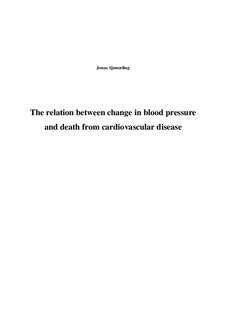| dc.description.abstract | Background: It is well established that high blood pressure (BP) increase the risk of death from cardiovascular diseases (CVD). However, most studies have focused on baseline BP, and relatively few have examined the effects of a change in BP over a period of time.
Design: Population-based prospective cohort study with 11 years of follow-up.
Methods: The study was carried out using data from the population-based Nord-Trøndelag health study (HUNT) linked with the Cause of Death Registry at Statistics Norway. BP measurements from HUNT 1 (1984-96) and HUNT 2 (1995-97) were used to calculate individual change in BP between the surveys. A total of 25,187 women and 22,099 men were followed up on cause of death from baseline in HUNT 2. We used Cox regression to analyze the effect of both relative and absolute changes in BP, separately for men and women, and also stratified by physical activity level.
Results: During follow-up, 2,084 men and 1,854 women had died from CVD. An absolute increase in Systolic BP of ≥40 mmHg was associated with an increase in risk ratio (RR) of 1.1 (95 % confidence interval (CI) 0.9-1.3 and 0.9-1.4) in both men and women, compared to having a stable BP (-4 to +4 mmHg). On the other hand, a decrease in Systolic BP of ≥20 mmHg was associated with an increase in RR of 1.8 (CI 1.5-2.2) and 1.9 (CI 1.5-2.2) for men and women respectively, compared to being stable. For diastolic BP, the largest increase (≥40 mmHg) was associated with a RR of 1.3 (CI 1.1-1.6 and 1.0-1.5) in both men and women compared to a stable BP. Relative changes in BP showed a similar pattern; the strongest effect was observed among people who reduced their BP between the surveys. However, having a high systolic BP (≥140 mmHg) at both surveys resulted in a RR of 1.4 (CI 1.2-1.7) in men and 2.0 in women (CI 1.6-2.5). There were no large differences in the estimated associations when comparing physically active to inactive, although active people who increased their systolic BP with ≥40 mmHg had a RR of 1.5 (CI 1.0-2.4), whereas this was not evident among the inactive.
Conclusion: Overall, a reduced BP was associated with the highest of death, but the risk was also increased among people with the largest increase in BP, and among those who had a stable high blood pressure. There were marginal differences in the association between BP and risk of death being active and inactive persons. | nb_NO |
